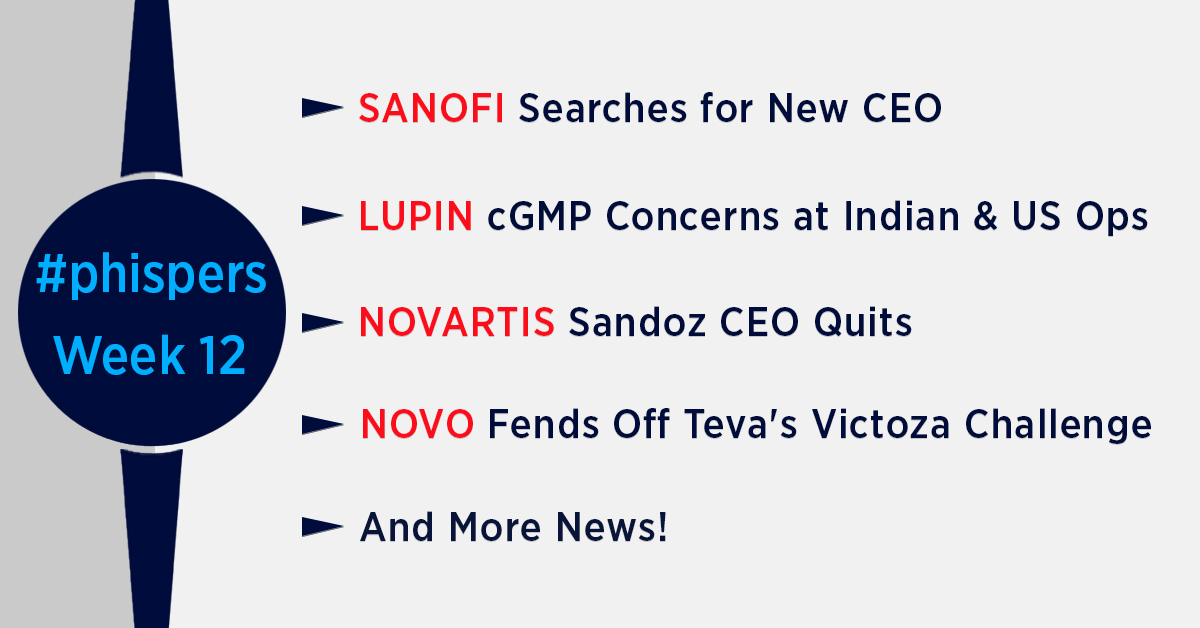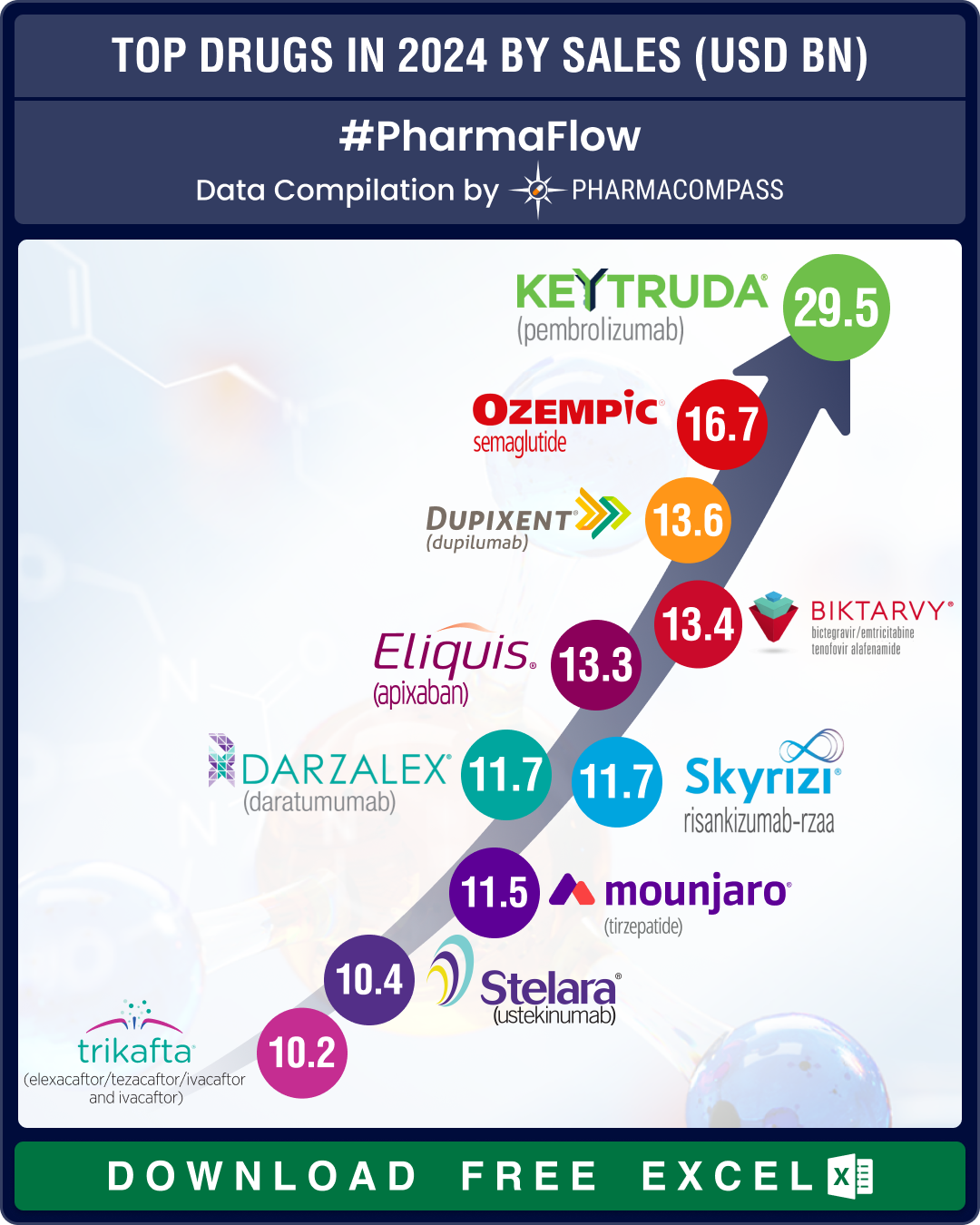
By PharmaCompass
2019-03-21
Impressions: 3948
This week, Phispers brings you news about the CEOs of Sandoz and Sanofi.
While Richard Francis, CEO of Novartis’ generic unit, stepped down as he couldn’t commit to Sandoz’s multi-year journey, Sanofi said it is working on a succession plan, as CEO Olivier Brandicourt would retire in 2021.
Meanwhile, Novo Nordisk got a reprieve of at least four years to build its newer diabetes drugs before Teva launches copies of its blockbuster Victoza in the US.
Fresh data from REDUCE-IT study showed Amarin’s Vascepa cuts heart problems by 30 percent. And Indian drugmaker Lupin received another blow recently as two of its manufacturing sites — one in India and another in the US— received an OAI letter, that raises concerns over cGMP compliance.
Sandoz CEO Richard Francis steps down,
reigniting split-off rumors
Last month, we shared news about Novartis’ struggling generics division — Sandoz — and how its future is in question after a revamp, scheduled to take place over the next 18 months. More questions were raised about the future of Sandoz when last week its CEO Richard Francis said he is unable to “commit to (Sandoz’s) multi-year journey”.
Francis took the helm of Sandoz in 2014, after putting in 13 years at Biogen where he held various executive roles.
In a statement, Francis pointed to the evolution taking place at Sandoz as the main reason behind his departure. “I realize that this is a multi-year journey which I cannot commit to and therefore have decided that now is the right time to step down,” he said. Francis (51) will step down on March 31, Novartis said.
Francesco Balestrieri, head of Sandoz’s Europe region, will become interim CEO and oversee what Novartis CEO Vasant Narasimhan termed “a multi-year transformation program” in which Sandoz will re-focus on biosimilars and hard-to-make generics.
In September last year, Novartis sold selected portions of its Sandoz US portfolio, specifically the Sandoz US dermatology business and generic US oral solids portfolio, to Aurobindo Pharma. Since then, there have been rumors that Novartis wants to split off Sandoz.
However, Novartis has been repeatedly squashing rumors that it will split-off the generics business. Earlier this month, chairman Joerg Reinhardt, reportedly told a Swiss business newspaper Finanz und Wirtschaft: “Sales are not planned at the moment. There are also no specific considerations that would have the goal of separating Sandoz.”
FDA raises cGMP concerns in OAI letter issued to Lupin’s sites in India, US
In yet another blow to Indian generic major Lupin, two of its manufacturing sites — one in India and another one in the United States — received ‘Official Action Indicated’ (OAI) letters from the US Food and Drug Administration (FDA).
The firm informed the stock exchange that it had received a letter from the FDA classifying the inspection conducted at the company’s Mandideep (Unit 1) and Somerset (New Jersey) facilities in December 2018 as OAI, which means the facilities are considered to be in an unacceptable state of compliance with regard to current good manufacturing practice (cGMP).
According to a Lupin spokesperson, the letter Lupin received from the FDA is a 90-day facility classification decisional letter. “We are taking corrective actions and communicating them to the FDA as we strive towards a positive outcome,” the spokesperson informed PharmaCompass through an email.
Lupin’s Mandideep plant has two units. Unit-1 makes cephalosporin active pharmaceutical ingredient (API) and cephalosporin solid oral dosage (antibiotic) and unit-2 produces cardiovascular Pril APIs (to treat high blood pressure).
Although the Mandideep plant is not a major contributor to its revenues and there are no new DMF and ANDA applications pending review or approval from the Mandideep (Unit 1) facility and the company does not believe that this action will have an impact on disruption of supplies or on the existing revenues from operations of this facility, manufacturing problems continue to plague Lupin.
The firm’s operations in Indore and Goa received warning letters in 2017 and less than a month ago, PharmaCompass had reported on how following the warning letter issued in 2017, an FDA Form 483 posted by the agency had highlighted recurring compliance issues at the Indian drug major’s Goa facility.
In addition to Lupin, there were also reports of concerns at Aurobindo’s sterile manufacturing operations in India. According to BloombergQuint, the FDA had 11 observations in a Form 483 issued to its operations at Unit 16 in Telangana.
Sanofi begins hunt for new CEO; Gilead’s outgoing CEO bags US$ 10 million hike in compensation
French drug major Sanofi is working on a plan to find a new CEO, as the current chief executive Olivier Brandicourt, will retire in 2021. The plan is being worked out in agreement and in consultation with Brandicourt,
As per the company’s rules, Brandicourt is required to step down at 65, an age he will attain in February 2021.
There is buzz about Sanofi holding internal discussion about succession planning. “It is the responsibility of any company’s board of directors to consider and plan for the succession of its CEO and executive committee members by identifying the next set of future leaders,” a spokesperson for Sanofi said. “With this perspective, the board has been considering this succession plan for some time now, in agreement and consultation with our CEO.”
Next month, Sanofi is holding an annual meet wherein shareholders will be asked to vote to renew the mandate of the board’s chairman, Serge Weinberg.Brandicourt was hired in 2015 to help revive the fortunes of France’s biggest drugmaker. Since then, Brandicourt has been actively reshaping the business. He was previously the head of Bayer’s healthcare arm.
The news comes a week after Brandicourt’s 2018 pay was cut by 25 percent — to US$ 8.2 million — as a result of Sanofi’s falling revenues.
Meanwhile, another outgoing CEO, John Milligan of Gilead Sciences, who stepped down in July last year, raked in a huge salary hike in 2018.
Milligan racked in US$ 26 million in compensation for last year, an increase of US$ 10 million over his 2017 package. His salary increased by US$ 1.58 million and his cash incentive pay increased to US$ 3.34 million.
It was Milligan’s stock and option awards that took a major leap. A FiercePharma report states this is thanks to his “separation agreement” with Gilead. Milligan seized share awards worth US$ 9.86 million and options valued at US$ 11.13 million.
Novo gets four-year reprieve in US from Teva’s Victoza copycats
In the US, Novo Nordisk has got a reprieve of at least four years to build up its newer diabetes drugs before Teva Pharmaceuticals USA launches generic copies of its blockbuster drug Victoza. In a statement issued by Novo this week, the Danish drugmaker said it has reached a settlement with Teva on the US patent litigation case for Victoza (liraglutide). Consequently, Teva is licensed to launch a generic version of Victoza only after December 22, 2023.
“Under certain circumstances, Teva could launch a generic version of Victoza earlier, but not before March 22, 2023, unless the Victoza patents are no longer in force or there is another generic version of Victoza on the market. If Novo Nordisk is granted six months pediatric extension for Victoza, all above-mentioned timelines will be extended by six months,” Novo said in a statement.
That gives Novo time to grow its weekly GLP-1 (short for glucagon-like peptide 1) drug Ozempic, (semaglutide) approved in late 2017 as a follow-up to the daily Victoza, and its forthcoming oral version of the same drug before those newer medications face Victoza generics.
Novo is hoping to get oral semaglutide to the FDA within weeks, so that the approval comes in before the year-end.
The drugmaker has a lot riding on its new generation GLP-1 drugs, as competing drugs in the class — such as Eli Lilly’s Trulicity — eat into Victoza’s market share.
Victoza brought in US$ 2.67 billion for Novo last year, up 8 percent over the drug’s 2017 revenues. In comparison, Ozempic sales were US$ 273 million last year.
Teva has been challenging Novo’s patents and has been working towards launching its own version of Victoza since 2017. In February 2017, Teva said it filed an FDA application for a Victoza copycat and that it believed it was a “first filer,” which would make it eligible for 180 days of generic exclusivity.
Fresh
data from REDUCE-IT study shows Amarin’s Vascepa cuts heart
problems by 30%
Fish oil contains omega-3 fatty acids, such as eicosapentaenoic acid (EPA) and docosahexaenoic acid (DHA), and both are known to lower serum triglycerides, or high cholesterol. Amarin’s Vascepa (an FDA-approved prescription EPA treatment) seeks to leverage that hypothesis and change the way cholesterol has been treated.
In September, Amarin released initial results from the study of 8,179 patients already taking other heart drugs. Known as REDUCE-IT, the study showed a 25 percent reduction in serious heart events for those receiving a 4 gram dose of Vascepa compared with a placebo.
However, in November the clinical trial design of the REDUCE-IT study was questioned. Though the drug did cut heart risks significantly, the choice of placebo and the effect it had on the results had stirred up a debate.
But this week, the drugmaker published fresh data from the REDUCE-IT study. This time, the results show a 30 percent decrease in serious heart problems.
The new data shows an average drop of “12 deaths, 42 heart attacks (myocardial infarctions), 14 strokes, 76 coronary revascularizations and 16 episodes of hospitalization for unstable angina”. There was also a 28 percent reduction of total events in the key secondary endpoint of 3-point MACE (short for major adverse cardiac events) in the intent-to-treat population consisting of a composite of cardiovascular death, non-fatal heart attack and non-fatal stroke.
Amgen taps Jay Leno for cholesterol awareness: Another company that focuses on cholesterol-lowering drugs is Amgen, whose drug Repatha has been on the market since 2015. Amgen is partnering with comedian and TV show host, Jay Leno, to sound the alarm on high cholesterol. The awareness campaign — Cholesterol 911 — aims to motivate patients and caregivers to get into the driver's seat insofar as cholesterol management is concerned.
Leno, himself a high-cholesterol patient, displays his love for cars, and deploys his sense of humor in the campaign to spread awareness about high cholesterol.
Through this campaign, Amgen is targeting high-risk patients with cardiovascular disease and people who have previously suffered a heart attack or stroke. These patients “need to know that there is more that can and should be done to further lower their LDL-C or ‘bad’ cholesterol in order to reduce their risk of another cardiovascular event,” Amgen’s spokeswoman said.
The headline and our report on Lupin was updated on March 23, 2019, following a clarification from the company that it had not received a warning letter for its US and India facilities, but an OAI, which is a 90-day facilities classification decisional letter. The error carried in our previous version is regretted.
The PharmaCompass Newsletter – Sign Up, Stay Ahead
Feedback, help us to improve. Click here
Image Credit : #Phisper Infographic by SCORR MARKETING & PharmaCompass is licensed under CC BY 2.0
“ The article is based on the information available in public and which the author believes to be true. The author is not disseminating any information, which the author believes or knows, is confidential or in conflict with the privacy of any person. The views expressed or information supplied through this article is mere opinion and observation of the author. The author does not intend to defame, insult or, cause loss or damage to anyone, in any manner, through this article.”







